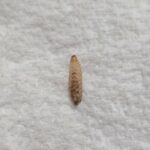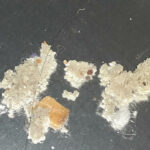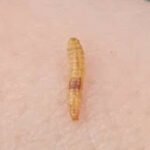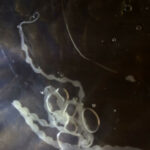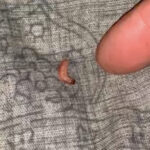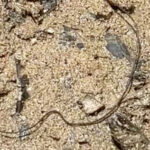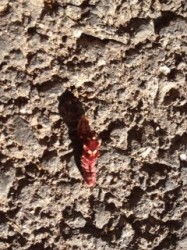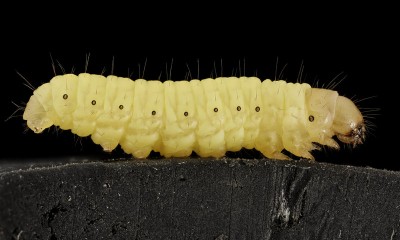
A man who experienced a bee swarm inside the brick wall of his house later discovers worms in his living room. According to our reader, the worms are small, maggot-like worms, and they seem to be coming from under the “plates” of the living room, which we assume refers to the floor of the room.
Although our reader did not provide photographs of the worms, he did have a go at guessing what the worms may be: wax worms, and we think he is absolutely correct. Not only do wax worms resemble maggots (the larvae of species of flies), but they do feed on beeswax. In fact, this is where they get their name from. The term ‘wax worm’ refers to the larvae of any species of wax moth, which includes those species of moth that infiltrate honeybee hives to eat their beeswax and destroy their colonies. Other names for them include: web worms, wax millers, and bee moths.
Species of moths that are included in the umbrella term ‘wax moth’ include: the greater wax moth (or simply, GWM), the lesser wax moth, the indianmeal moth (a common household pest that also eats grains, and other foods in the kitchen), and the Mediterranean flour moth, according to Charles Kwadha et al.’s text: The Biology and Control of the Greater Wax Moth, Galleria mellonella. Furthermore, these maggot-like larvae hatch at a length of around 1-3mm, but can later grow to be 25-30mm. These also have a set of teeth, which is necessary for combing away the beeswax from inside a hive (excuse the pun). What sets these critters apart from maggots, other than their diet and typical location of discovery, is the fact that they have legs. Excluding their forelegs, wax worms have a set of six other legs, while maggots have no legs.
The lifespan of a wax moth, from egg to mature moth varies; they can live for weeks, or up to several months, so an infestation of these critters can stick around for a while, especially if one does not rid their home of them before they mate and lay eggs all over again. In terms of getting rid of wax moths, short of tearing out all the walls and floors to try and rid the house of every last bit of honeycomb and other bees wax, there is unfortunately not much one can do besides wait. The only reason these worms are still residing underneath the flooring of our reader is because there is leftover beeswax, and as long as that is still there, more wax worms will be attracted to our reader’s house. The good news is that wax worms don’t eat anything else, and they will clear all of that beeswax and bee residue out from behind your walls and then move on, so aside from having unwanted roommates for up to a few months there is little downside. Once they have eaten up all the residue, they should leave the house. Unless, however, they are indianmeal moth larvae, because in that case they will move on to the kitchen to snack on his pantry.
In order to get a conclusive identification of which species of wax worm our reader is dealing with, we encourage him to bring a sample of the worms (alive) to his county’s local Extension Office, as they will be able to provide professional input and help with dealing with the infestation. This piece of advice came from a response from David S. on Ask An Expert.
To conclude, the maggot-like worms our reader has been finding in his living room in the wake of the bee swarm are, as our reader guessed, wax worms. Although they are considered pests, they are harmless to humans, and should disappear of their own accord once they are done eating up the residue from the bee hives.
All About Worms is always free, always reader-supported. Your tips via CashApp, Venmo, or Paypal are appreciated! Receipts will come from ISIPP Publishing.
You might also find these guys interesting!





